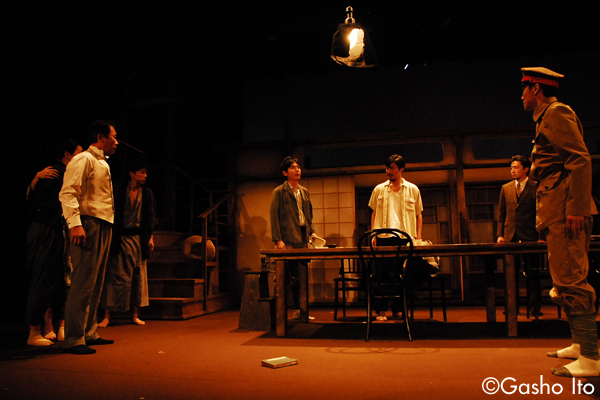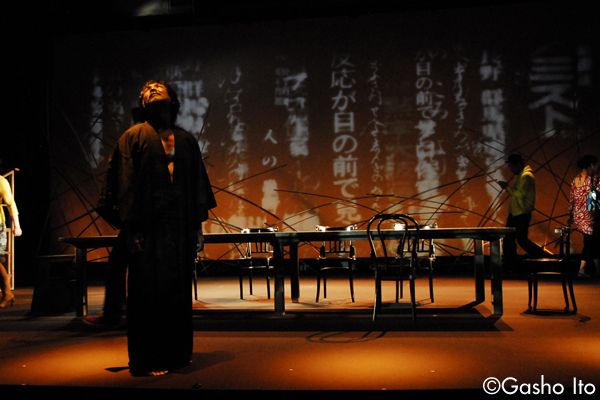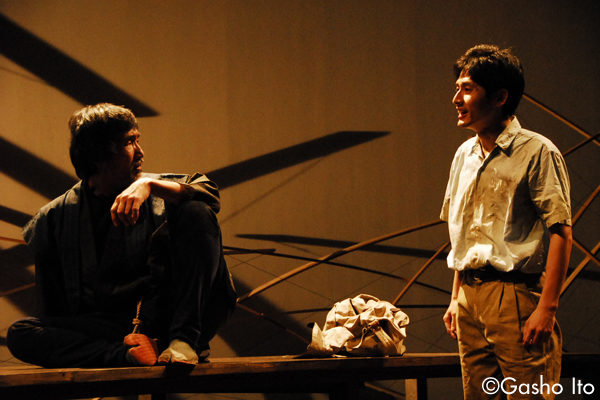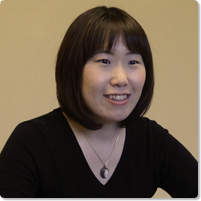Scene I: In the Attic Museum’s assembly room in July of 1945 with Japan’s WWII defeat and surrender just a month away. A servant woman of the Shibusawa estate name Riku is cleaning the room in preparation to receive people who have lost their homes in the Allied bombing of Tokyo. Suddenly, Tsuneichi appears and announces that he has been summoned by the War Office. Shibusawa sends Tsuneichi off, promising that he will do everything in his power to protect him from any harm.
Scene II: In the Attic Museum’s assembly room in October of 1935. The room is alive with the conversation of researchers Toshio Kiryu, Shuji Yoshinaga and Itsuma Hayashi, a student of folklorist Kunio Yanagida named Tetsuro Ikuta and the head of the estate’s female servants, Shino. Shibusawa’s wife, Takako, a daughter of the Iwasaki family of the Mitsubishi industrial group, is perplexed by the way her husband gives free rein to his researchers in the name of “field work.”
Tsuneichi, who has been invited to the museum by Shibusawa, enters the room led by Katsura Ichinose, who collaborates with Shibusawa in the collection of folk tools and crafts, and the servant in training, Riku. Seeing Katsura enthusiastically discussing with Shibusawa and the researchers the handmade Japanese sandals he has collected with the help of blind female traveling musicians, Ikuta is planning to ask for a transfer.
Impressed by the essay written by Tsuneichi about his home island of Suo Oshima, Shibusawa asks him to become a researcher to seek out material about the country’s folk culture. Tsuneichi shows reluctance, citing his responsibilities at his job and to his wife and children, but Shibusawa says that he wants him to go out and live among the nameless farmers and fishermen and record their culture as he sees it before the country’s traditional lifestyles and folk culture are lost forever.
Scene III: In front of Tsuneichi Miyamoto’s home in Osaka. Returning home, Tsuneichi tells his pregnant wife Maki that he plans to quit his job and work as a teacher and work as a folklorist under Shibusawa. Maki protests vehemently but her words don’t change Tsuneichi’s resolve.
Scene IV: An imaginary scene in Suo Oshima of Yamaguchi Prefecture. Tsuneichi becomes one with the natural world of his hometown as he records the peoples’ lifestyles and culture.
Scene V: In the assembly room at the Attic Museum in July of 1939 when the Japanese and Soviet armies are engaged in battle at Nomonhan in Manchuria on the eve of World War II. Tsuneichi has returned from a survey in southern Kyushu but he is followed by a lieutenant from the army military police headquarters named Hiruma who is accusing him of being a spy, but Shibusawa sends the lieutenant away.
Professor Kudo, who is moving to the Kenkoku University Japan has established in Manchuria, asks Tsuneichi to join him there as an assistant professor, but Shibusawa refuses the offer. Shibusawa has already foreseen that the conflict on the continent will lead to the second World War and that Japan has no chance of emerging victorious. He says that when Japan is eventually defeated, the records they are accumulating of the lifestyles and folk culture of the Japanese will be essential for rebuilding the country. So, he will not send Tsuneichi and his other researchers off to what will become the killing fields abroad.
Shibusawa coins a new word
jomin
meaning “the common people” by combining the characters for “the people” and what is “always there,” and when he feels the time is right, he changes the name of the Attic Museum to the Institute for Research of the Culture of the Common People of Japan.
Scene VI: Tsuneichi is doing folk culture research. Crossing a pass in the mountains near the border of Shimane and Hiroshima prefectures, he meets a local farmer named Matsutaro and asks him if has any interesting stories he can tell. Matsutaro tells him about his father, a fisherman, who paddled his dugout canoe from island to island until he eventually reached China. Tsuneichi travels on in this way recording the memories of nameless people like horse traders and fishermen.
Scene VII: The scene returns to the assembly room, now in May of 1942. Shibusawa has been appointed vice-president of the Bank of Japan. To Ikuta and Hiruma who have come to congratulate him, Shibusawa answers curtly that he is being to discard the common people and join the bureaucracy and become an accomplice in the war effort because of the threats of [military government leader] Hideki Tojo.
Ikuta tells Shibusawa’s folklore researchers that he is establishing an “Ethnic Research Institute” in the Ministry of Education and invites them to come and work there as a place where they can do meaningful research even in these times of war. However, this is also a path that will be used to support the nationalist citizen policies of the wartime government.
The people gathered in the assembly room are talking about the meaning they find in their work as folklorists. Tsuneichi speaks. He says, “What the folklorist listens to is the words in the wind. The common people who didn’t have written words passed down their stories from parent to child, from mouth to mouth, and if their words, their memories are left unrecorded, they will be scattered by the wind and forgotten. Who except we folklorists will put these words down in a form that will live on? Only the words that we record will stand the test of time! They will live on to become the next memories!”
Shibusawa convinces Tsuneichi to return to his family and then announces that the Institute’s activities will be suspended for a time.
When Tsuneichi says that he feels as if he has cast off to the wind, Riku tells him, “The people you have met in your fieldwork are not connected to the master, Shibusawa. They are connected only to you.” Tsuneichi entrusts the records he has been keeping ever since coming to the Institute to Riku, with the words, “Until the day comes when I can continue writing.”
Scene VIII: It is now 1945 and Osaka is being hit by Allied air raids. The records and materials Tsuneichi has gathered and his unpublished manuscripts have burned in the bombing at his home. His wife tells Tsuneichi to flee to Suo Oshima where their son has been sent to escape the bombing, but Tsuneichi turns away, saying there is important work he must do.
Scene IX: It is 1945 on a mountain pass on the border of Shimane Prefecture. Tsuneichi has been asked by the Osaka municipal government to do a study of ways to get food from the farmers in the countryside to feed the people of Osaka, and he has come here to meet Matsutaro again. It is a journey to revisit the farmers that he previously met in his fieldwork as a folklorist. Tsuneichi is now trying to use the network of farmers he built up in the past to find ways to get food for the now starving nation. He listens as the farmers tell him about methods used in the past to get food from the stems of taro potatoes and other useful information. Tsuneichi says that the work he is doing now will be important when they begin rebuilding the country anew after the War. He continues his journey of research without time to rest. Seeing Tsuneichi press onward, Matsutaro says that his figure gives the appearance of a boat, of an ark crossing the land.
Scene X: It is July of 1945 in the assembly room. Hiruma, who is now a major in the War Preparations Department charged with the task of securing food provisions, has come to see Tsuneichi. Convinced that Japan’s defeat is imminent, Shibusawa, Hiruma and Tsuneichi are talking about how to secure enough food to keep the people alive. Shibusawa has been thinking about taking responsibility into his own hands to dissolve the big industrial conglomerates (
zaibatsu
) to rebuild the country after the War. His wife Takako (a daughter of the Mitsubishi
zaibatsu
Iwasaki clan) tells him., “You are on the side of the nameless common people. But I will leave this house and return to the Iwasaki family and live to the end with my family pride.
It is after the Japanese surrender and War is over. Preparing to set out on another journey, Tsuneichi is meeting with Shibusawa near Tokyo Station before he departs. His will be a journey to visit once again the nameless common people as they rebuild their lives amid the rubble of the war-torn landscape. The two begin to walk, “Across this land, as far as we can go.”





